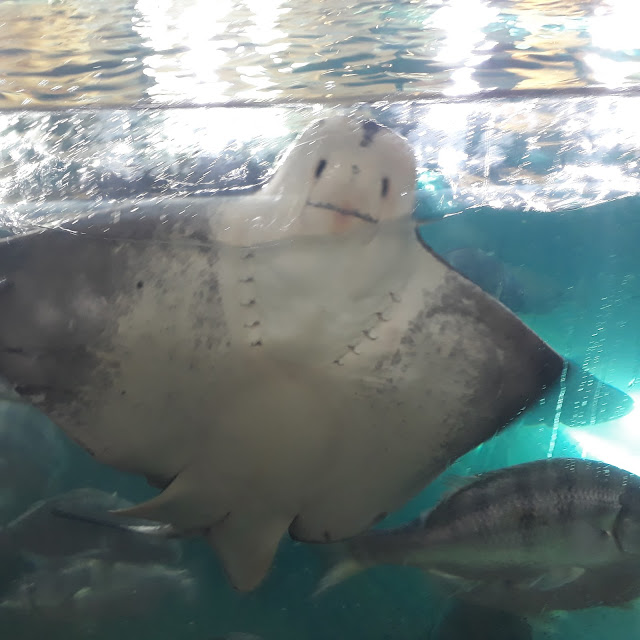Video of Marine Aquarium in Swakopmund, Namibia, part 1 of 3.
#MarineAquariumSwakopmund #NamibiaWestCoast #SouthernAfrica
The National Marine Aquarium of Namibia is located in the coastal town of Swakopmund, wedged between Atlantic Ocean and Namib Desert.
YouTube video:
This recently overhauled waterfront aquarium provides an excellent introduction to the cold offshore world in the South Atlantic Ocean. Most impressive is the tunnel through the largest aquarium, which allows close-up views of graceful rays, toothy sharks and other little marine beasties.
Fish feeding is every day at 15h00. On Tuesdays, weekends and public holidays, a diver (if available) will handfeed the fish.
Species that may be viewed in the Aquarium
Galjoen, West Coast Steenbras, Baardman, Ragged-tooth Shark, Shyshark, Kipfish, African penguin, Cape cormorant, Blacktail, Redfingers, Horse mackerel, Octopus, Green turtle, Pipefish, hermit crab, kelp gull, White pelican, Anemone, Horseshoe sea cucumber, Spotted grunter, Mullet, Spotted gully shark, Blue-spotted ray, Sand shrimp, Crumb-of-bread sponge, Silver kob, Barbel, Houndshark, Eagle, ray, Hawksbill turtle, Three-spot swimming crab, Red crab, Cape fur seal.
Commercial species of Namibia
Chub mackerel, Horse mackerel, Deepwater hake, Orange roughy, Alfonsino, West Coast Sole, Kingklip, Cape hake, Mako shark, Red crab, Cape rock lobster, anchovy, Pilchard, Mullet, Silver, kob, Monkfish, Swordfish, Snoek, Yellowfin tuna, Blue shark and Cape fur seal.
The National Aquarium in Swakopmund opens a window to the wonders of marine life found in the cold Benguela Current off the coast of Southern Africa.
Seawater, drawn from the old jetty, is pumped through a series of filter systems before reaching the exhibition tanks. The main tank has a holding capacity of 320 000 litres, is 12 m long and 8 m wide. An underwater walk-way allows the visitor to view sharks, rays and fishes from close range. The smaller exhibition tanks house organisms from the inshore waters, mainly found along sandy and rocky beaches.
Numerous information posters line the walls of the Aquarium. Scientific information, regarding the rich resources of Namibia, is simply, yet comprehensively displayed.
The functions of the National Marine Aquarium are to disseminate information about Namibian marine life, to enhance visitors about the sensitivity and complexity of the Benguela System and to serve as a place of recreation for those who merely want to put their feet up and relax.
Feeding takes place each day at 15h00. Fishes in the main tank are fed 8-10 kg of filled hake. Special feeds are prepared for the filter-feeders (such as mussels and barnacles) and smaller creatures such as crabs, anemones, starfishes and sea snails.
The goals of the National Marine Aquarium are to spread information about Namibian marine life and to enhance knowledge about the sensitivity and complexity of the Benguela system.
Species that can be seen at the aquarium include Galjoen, West Coast Steenbras, Baardman, Ragged-tooth Shark, Shyshark, Kipfish, African Penguin, Cape cormorant, Blacktail, Redfingers, Horse Mackarel, Octopus, Green Turtle, Pipefish, Hermit Crab, Kelp Gull, White Pelican, Anemone, Horseshoe Sea Cucumber, Spotted Grunter, Mullet, Spotted Gully Shark, Blue-spotted Ray, Sand Shrimp, Crumb-of-bread Sponge, Silver Kob, Barbel, Houndshark, Eagle, Ray, Hawksbill Turtle, Three-spot swimming Crab, Red Crab and Cape fur Seal.
The more commercial species include Chub Mackerel, Horse Mackerel, Deepwater Hake, Orange roughy, Alfonsino, West Coast Sole, Kingklip, Cape Hake, Mako Shark, Red Crab, Cape rock Lobster, Anchovy, Pilchard, Mullet, Silver, Kob, Monkfish, Swordfish, Snoek, Yellowfin Tuna, Blue Shark and Cape fur seal.
Seawater is drawn in from the old jetty and pumped through various filter systems into the exhibition tanks.
Aerial photo/video service/inquiries: info@traveltonamibia.com








No comments:
Post a Comment